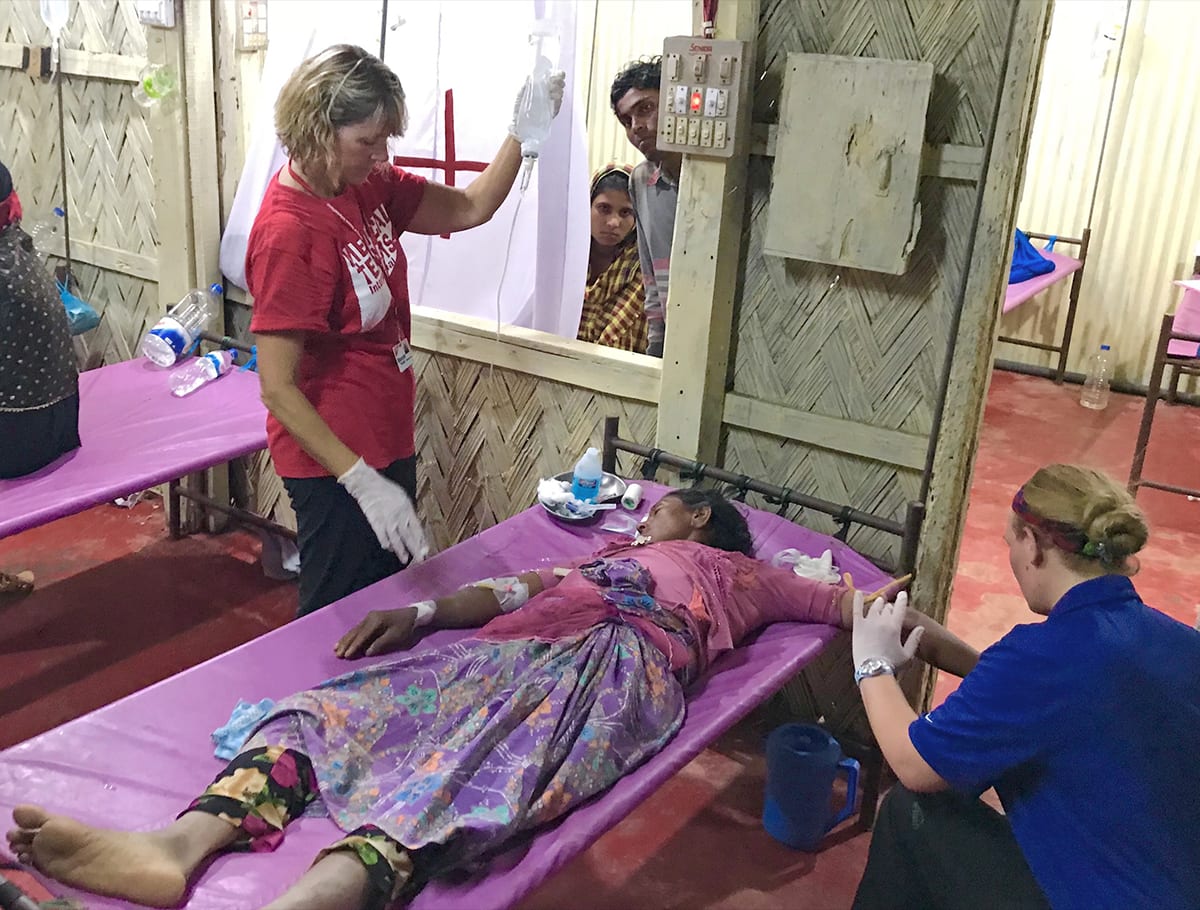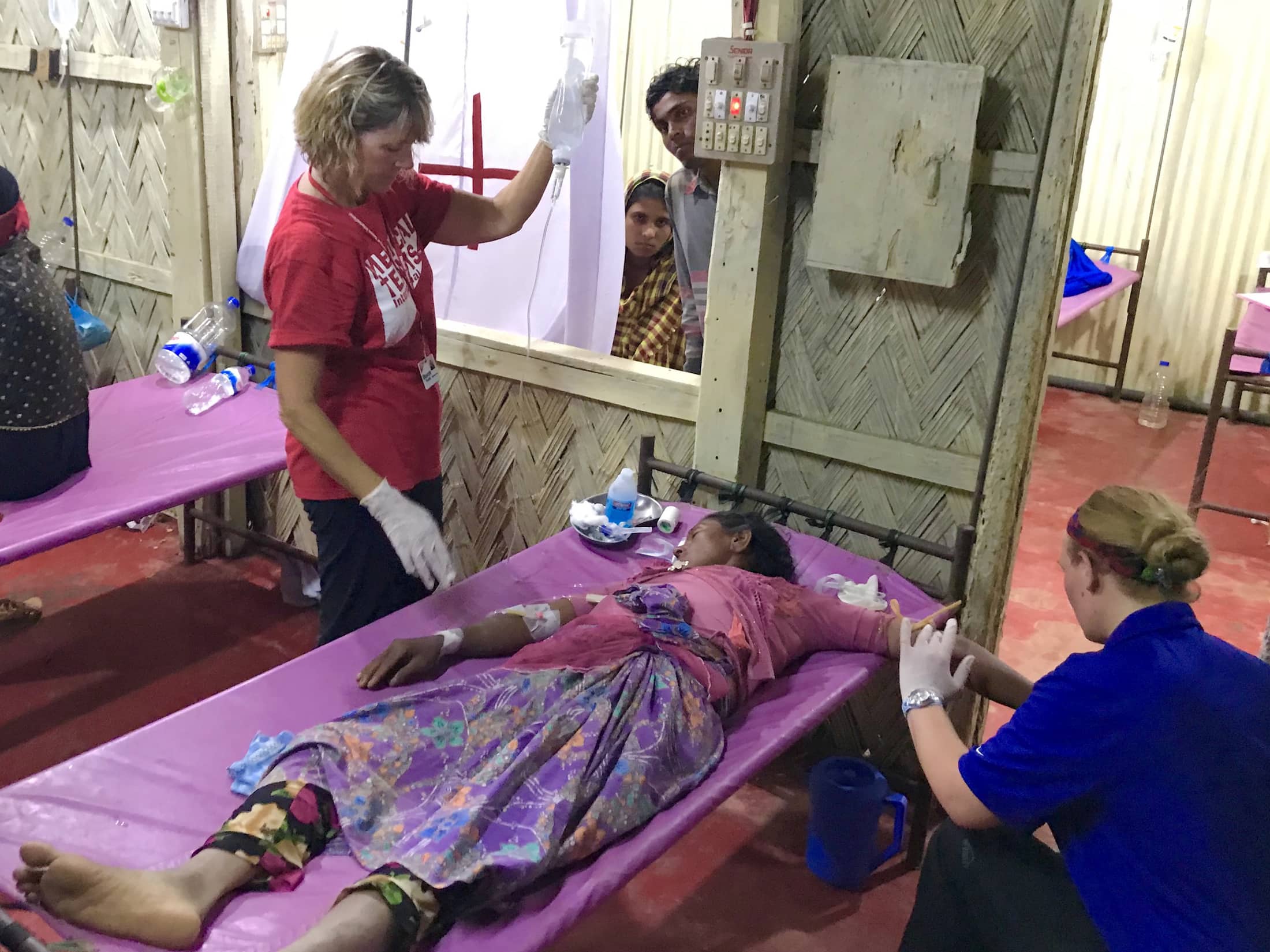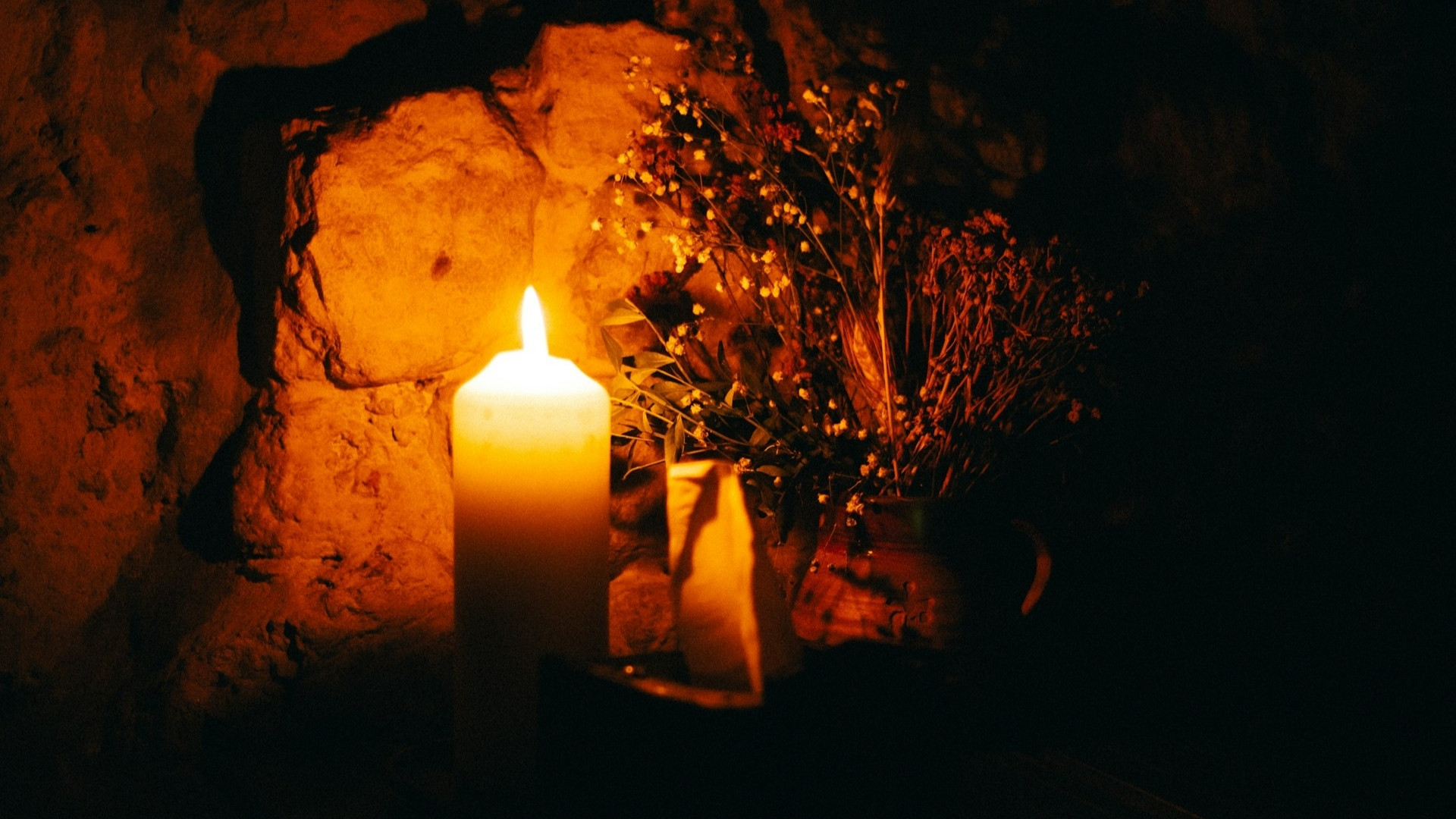[vc_row][vc_column][vc_column_text]

[/vc_column_text][/vc_column][/vc_row][vc_row el_class=”hero-header-text”][vc_column][vc_column_text]
‘It’s horrific’
More than 800,000 refugees fleeing ethnic cleansing have overwhelmed a Bangladesh camp where Covenant World Relief partner Medical Teams International was among the first to provide health care.
By Stan Friedman | Photos: United Nations, Sharon Tissell, Medical Teams International
[/vc_column_text][/vc_column][/vc_row][vc_row][vc_column][vc_column_text]Pictured above: Covenanter Sharon Tissell administers fluids to a refugee who nearly died due to severe dehydration.
[/vc_column_text][vc_column_text]PORTLAND, WA (December 1, 2017) – Nurse Sharon Tissell has treated sick and wounded refugees around the world in countries that include Syria and Iraq, but the crisis unfolding in Bangladesh as more than 800,000 Rohingya flee ethnic cleansing by the Myanmar army is the worst she has ever seen.
“It’s horrific,” says Tissell, a member of Eastridge Covenant Church in Portland who recently spent three weeks working with Medical Teams International at the Kutupolong refugee camp in Bangladesh just across the nation’s border with Myanmar.
“The stories are all similar,” Tissell wrote home during her time in Bangladesh. “They tell of troops parachuting into their villages. Of family members being tortured, decapitated, bodies desecrated, and children molested. These are the most horrible stories I have ever heard. I do not know how they can function at all. It is unimaginable.”
Tissell laments that what experts have called the world’s fast-growing refugee crisis has gone little noticed in much of the world, including the United States.
The Rohingya people have suffered violence and discrimination in the majority-Buddhist country for decades, but the latest catastrophe began on August 25, when a group of Rohingya insurgents attacked several security outposts and killed 12 security officers.
The Myanmar military responded by launching what the United Nations High Commissioner for Refugees has called “a textbook example of ethnic cleansing.”[/vc_column_text][/vc_column][/vc_row][vc_row][vc_column][vc_video link=”https://vimeo.com/245057177″ align=”center”][/vc_column][/vc_row][vc_row][vc_column][vc_column_text]Refugees travel crammed in fishing boats that cross the mouth of the Nef river where it empties into the Bay of Bengal. The tiny boats frequently capsize, and many passengers drown.
Tissell and a co-worker were driving along the coast on a beautiful sunny day when they came upon the site where bodies from a boat that had capsized the day before were found, most of them children.
“The bodies were already shrouded and were being carried up to the roadside to be buried,” Tissell said. “There is no way to identify them and notify their relatives. I am heartbroken as I think of what these mothers and children must have gone through in their attempt for safety. These refugees are caught between unimaginable persecution and great peril in their path to safety. But they have no choice if they want to survive.”[/vc_column_text][/vc_column][/vc_row][vc_row][vc_column][vc_single_image image=”37199″ img_size=”full” alignment=”center” el_class=”hero-img-tall”][/vc_column][/vc_row][vc_row][vc_column][vc_single_image image=”37200″ img_size=”full” alignment=”center” el_class=”hero-img-tall”][/vc_column][/vc_row][vc_row][vc_column][vc_single_image image=”37201″ img_size=”full” alignment=”center” el_class=”hero-img-tall”][/vc_column][/vc_row][vc_row][vc_column][vc_column_text]In the camps, the harsh life adds to the suffering. People of all ages carry “unbelievably heavy burdens on their backs,” Tissell said. “Large concrete conduits, mattresses, foodstuffs and hundreds of other items are carried on the shoulders or backs of people of every age.”
She was most concerned about the long lines of young children carrying heavy loads of firewood up and down steep hills,” Tissell said. “We know there are thousands of unaccompanied and orphaned children in Kutupolong, and they are at great risk for exploitation. UNICEF is providing “safe space” areas for them to rest, learn, and even engage in play therapy.” But there is still a lot of work to be done to make sure they are not exploited.
Part of that therapy has been drawing pictures. Many of the children draw photos of their villages being attacked and on fire, people being shot, or boats capsizing.[/vc_column_text][/vc_column][/vc_row][vc_row][vc_column][vc_single_image image=”37203″ img_size=”full” alignment=”center” el_class=”hero-img-tall”][/vc_column][/vc_row][vc_row el_class=”hide-for-mobile”][vc_column][vc_single_image image=”37210″ img_size=”full” alignment=”center” el_class=”hero-img-tall”][/vc_column][/vc_row][vc_row el_class=”show-for-mobile”][vc_column width=”1/2″][vc_single_image image=”36787″ img_size=”full” alignment=”center”][/vc_column][vc_column width=”1/2″][vc_single_image image=”36648″ img_size=”full” alignment=”center”][/vc_column][/vc_row][vc_row][vc_column][vc_single_image image=”37211″ img_size=”full” alignment=”center” el_class=”hero-img-tall”][/vc_column][/vc_row][vc_row][vc_column][vc_single_image image=”37212″ img_size=”full” alignment=”center” el_class=”hero-img-tall”][/vc_column][/vc_row][vc_row][vc_column][vc_column_text]
HEALING
When MTI arrived three weeks after the crisis began, there already were several hundred thousand people in the camp. The areas “stretched out as far as the horizon – every inch covered with temporary shelter buildt of plastic sheeting, woven mats or whatever could be found,” Tissell emailed after her first day at the camp.
There is barely room to walk single file between shelters. The trail through the camp is loose dirt and it is easy to imagine, with any rain it would be almost in-passible. That is obvious by the deep ruts now thankfully dry. We traveled down a hill to see a muddy river full of gleeful children cooling off, only then to notice on the other side of the riverbank, the hill was littered with latrines. The water was certainly grossly contaminated.”
Diarrhea is the second-leading cause of death in the camp, but despite the massive population in Kutupalong, there had been no place to treat those who were suffering. The team worked with a local partner and the United Nations to set up the first Diarrhea Management Unit, with outpatient areas as well as inpatient wards. A week later, they launched a Primary Health Unit in an expansion area of the camp.
The teams treated people of all ages whose illnesses had caused mild to severe dehydration. Extreme dehydration causes organ failure and sepsis.
“Some require only a few hours of oral rehydration solution and others require large volumes of IV fluids, antibiotics and close monitoring for several days,” Tissell said. (See accompanying story on Tissell’s work around the world.)
As always in similar situation where there is “abysmal sanitation” and little clean water, the threat of other highly infectious illnesses such as cholera are a major concern. MTI members put in place extensive hygiene protocols have been established to reduce the transmission of diseases.
The teams also trained volunteer community health worker volunteers. They will visit each family in their camp area monthly to teach hand washing and safe food practices. They also screen for diarrheal diseases so they can be treated early. Training the local volunteers and medical personnel will be critical to any long-term success, Tissell says.[/vc_column_text][/vc_column][/vc_row][vc_row][vc_column][vc_single_image image=”37213″ img_size=”full” alignment=”center” el_class=”hero-img-tall”][/vc_column][/vc_row][vc_row][vc_column][vc_single_image image=”37214″ img_size=”full” alignment=”center” el_class=”hero-img-tall”][/vc_column][/vc_row][vc_row el_class=”hide-for-mobile”][vc_column][vc_single_image image=”37215″ img_size=”full” alignment=”center” el_class=”hero-img-tall”][/vc_column][/vc_row][vc_row el_class=”show-for-mobile”][vc_column width=”1/2″][vc_single_image image=”36553″ img_size=”full” alignment=”center”][/vc_column][vc_column width=”1/2″][vc_single_image image=”36554″ img_size=”full” alignment=”center”][/vc_column][/vc_row][vc_row el_class=”hide-for-mobile”][vc_column][vc_single_image image=”37216″ img_size=”full” alignment=”center” el_class=”hero-img-tall”][/vc_column][/vc_row][vc_row el_class=”show-for-mobile”][vc_column width=”1/2″][vc_single_image image=”36731″ img_size=”full” alignment=”center”][/vc_column][vc_column width=”1/2″][vc_single_image image=”36525″ img_size=”full” alignment=”center”][/vc_column][/vc_row][vc_row][vc_column][vc_column_text]
RESILIENCE
The United Nations has called the Rohingya people one of the most-persecuted minorities in the world and suffered violence for decades. When the latest exodus began, there already were 300,000 Rohingya living in Bangladesh following previous attacks by the Myanmar army.
Tissell said, “I was so struck by their resilience. The kind of horror they have seen – I just can’t imagine continuing. I think I’d just lay down and die. Just to be able to push on when you’ve lost everything and you’ve lost everything dear to you in such a horrible way. I don’t know how they understand how they go on.”
The violence the Rohingya had suffered made them uneasy at first when the team arrived, but that began to change.
“These people are really, really tough,” Tissell said. “But they also are really warm-hearted. I’ve been in situations where people are not always very charitable to outsiders, and these people were so kind.”
Tissell takes time to play with some of the young people and to encourage them and their families. I can be a draining task. But she loves it.
It is unclear how long the refugees will be allowed to stay in Bangladesh, already one of the world’s poorest countries. The country plans to move all of the refugees – some who have been scattered in different parts of Bangladesh into the Kutupalong camp and say the population has grown to more than 800,000 people. The government has said supporting the refugees will be “an impossible burden” and has considered whether to allow them to stay. They have put strict restrictions on their movement. Still, Tissell and humanitarian workers said they applauded the government for taking them in.
Meanwhile the refugees keep coming.[/vc_column_text][/vc_column][/vc_row]














